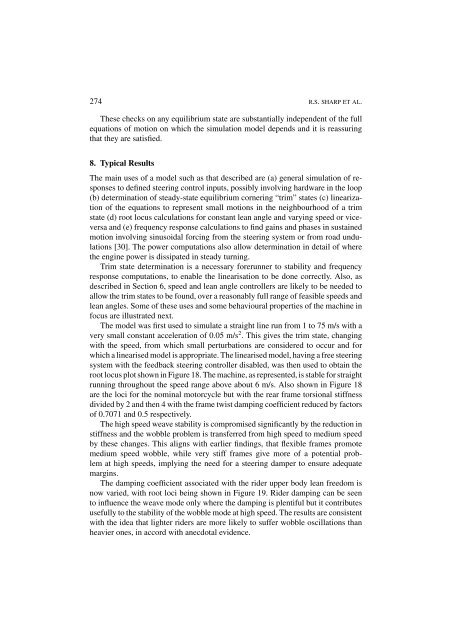Advances in the Modelling of Motorcycle Dynamics - ResearchGate
Advances in the Modelling of Motorcycle Dynamics - ResearchGate
Advances in the Modelling of Motorcycle Dynamics - ResearchGate
Create successful ePaper yourself
Turn your PDF publications into a flip-book with our unique Google optimized e-Paper software.
274 R.S. SHARP ET AL.These checks on any equilibrium state are substantially <strong>in</strong>dependent <strong>of</strong> <strong>the</strong> fullequations <strong>of</strong> motion on which <strong>the</strong> simulation model depends and it is reassur<strong>in</strong>gthat <strong>the</strong>y are satisfied.8. Typical ResultsThe ma<strong>in</strong> uses <strong>of</strong> a model such as that described are (a) general simulation <strong>of</strong> responsesto def<strong>in</strong>ed steer<strong>in</strong>g control <strong>in</strong>puts, possibly <strong>in</strong>volv<strong>in</strong>g hardware <strong>in</strong> <strong>the</strong> loop(b) determ<strong>in</strong>ation <strong>of</strong> steady-state equilibrium corner<strong>in</strong>g “trim” states (c) l<strong>in</strong>earization<strong>of</strong> <strong>the</strong> equations to represent small motions <strong>in</strong> <strong>the</strong> neighbourhood <strong>of</strong> a trimstate (d) root locus calculations for constant lean angle and vary<strong>in</strong>g speed or viceversaand (e) frequency response calculations to f<strong>in</strong>d ga<strong>in</strong>s and phases <strong>in</strong> susta<strong>in</strong>edmotion <strong>in</strong>volv<strong>in</strong>g s<strong>in</strong>usoidal forc<strong>in</strong>g from <strong>the</strong> steer<strong>in</strong>g system or from road undulations[30]. The power computations also allow determ<strong>in</strong>ation <strong>in</strong> detail <strong>of</strong> where<strong>the</strong> eng<strong>in</strong>e power is dissipated <strong>in</strong> steady turn<strong>in</strong>g.Trim state determ<strong>in</strong>ation is a necessary forerunner to stability and frequencyresponse computations, to enable <strong>the</strong> l<strong>in</strong>earisation to be done correctly. Also, asdescribed <strong>in</strong> Section 6, speed and lean angle controllers are likely to be needed toallow <strong>the</strong> trim states to be found, over a reasonably full range <strong>of</strong> feasible speeds andlean angles. Some <strong>of</strong> <strong>the</strong>se uses and some behavioural properties <strong>of</strong> <strong>the</strong> mach<strong>in</strong>e <strong>in</strong>focus are illustrated next.The model was first used to simulate a straight l<strong>in</strong>e run from 1 to 75 m/s with avery small constant acceleration <strong>of</strong> 0.05 m/s 2 . This gives <strong>the</strong> trim state, chang<strong>in</strong>gwith <strong>the</strong> speed, from which small perturbations are considered to occur and forwhich a l<strong>in</strong>earised model is appropriate. The l<strong>in</strong>earised model, hav<strong>in</strong>g a free steer<strong>in</strong>gsystem with <strong>the</strong> feedback steer<strong>in</strong>g controller disabled, was <strong>the</strong>n used to obta<strong>in</strong> <strong>the</strong>root locus plot shown <strong>in</strong> Figure 18. The mach<strong>in</strong>e, as represented, is stable for straightrunn<strong>in</strong>g throughout <strong>the</strong> speed range above about 6 m/s. Also shown <strong>in</strong> Figure 18are <strong>the</strong> loci for <strong>the</strong> nom<strong>in</strong>al motorcycle but with <strong>the</strong> rear frame torsional stiffnessdivided by 2 and <strong>the</strong>n 4 with <strong>the</strong> frame twist damp<strong>in</strong>g coefficient reduced by factors<strong>of</strong> 0.7071 and 0.5 respectively.The high speed weave stability is compromised significantly by <strong>the</strong> reduction <strong>in</strong>stiffness and <strong>the</strong> wobble problem is transferred from high speed to medium speedby <strong>the</strong>se changes. This aligns with earlier f<strong>in</strong>d<strong>in</strong>gs, that flexible frames promotemedium speed wobble, while very stiff frames give more <strong>of</strong> a potential problemat high speeds, imply<strong>in</strong>g <strong>the</strong> need for a steer<strong>in</strong>g damper to ensure adequatemarg<strong>in</strong>s.The damp<strong>in</strong>g coefficient associated with <strong>the</strong> rider upper body lean freedom isnow varied, with root loci be<strong>in</strong>g shown <strong>in</strong> Figure 19. Rider damp<strong>in</strong>g can be seento <strong>in</strong>fluence <strong>the</strong> weave mode only where <strong>the</strong> damp<strong>in</strong>g is plentiful but it contributesusefully to <strong>the</strong> stability <strong>of</strong> <strong>the</strong> wobble mode at high speed. The results are consistentwith <strong>the</strong> idea that lighter riders are more likely to suffer wobble oscillations thanheavier ones, <strong>in</strong> accord with anecdotal evidence.
















